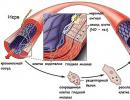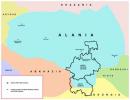Presentation on the topic of naval. Presentation on the topic "history of the navy." Northern Fleet sailors' sleeve insignia
Slide 1
Russian Navy
History of creation. Purpose
Lenkov Svyatoslav Viktorovich Teacher, organizer of life safety, MOAU Secondary School No. 50, Orsk named after V.P. Polyanichko
Slide 2

The Navy (Navy) is a branch of the Armed Forces of the Russian Federation. It is intended for the armed protection of Russian interests and for conducting combat operations in the sea and ocean theaters of war. The Navy is capable of delivering nuclear strikes on enemy ground targets, destroying enemy fleet groups at sea and bases, disrupting the enemy’s ocean and sea communications and protecting its maritime transport, assisting ground forces in operations in continental theaters of war, landing amphibious assault forces, and participating in repelling landing forces. enemy and perform other tasks.
Slide 3

Tasks of the Russian Navy
Conduct nuclear strikes on enemy ground targets; Destroy groups of his fleet at sea and in bases; Disrupt enemy ocean and sea communications; Protect your maritime transport; Defense of one's coast from the sea; Assist ground forces in operations on continental theaters of war; Land amphibious assault forces, etc.
Slide 4

Structure of the Russian Navy
Slide 5

Branch of the Russian Navy forces
Submarine Force; Surface Forces; Naval Aviation; Marines; Coastal defence; Special purpose units, rear units and units.
Slide 6

Submarine forces
Submarine forces are the strike force of the fleet, capable of controlling the expanses of the World Ocean, secretly and quickly deploying in the right directions, and delivering unexpected powerful strikes from the depths of the ocean against sea and continental targets. Depending on the main armament, submarines are divided into missile and torpedo submarines, and according to the type of power plant into nuclear and diesel-electric.
Slide 7

Submarine forces
The Russian Navy includes 13 nuclear-powered ballistic missile submarines, 27 nuclear-powered missile and torpedo submarines, 19 diesel submarines, 8 special-purpose nuclear submarines and 1 special-purpose diesel submarine.
Slide 8

Missile Submarine Cruiser pl941ak1 class (Typhoon - Shark)
Slide 9

Missile Submarine Cruiser pr.667BDRM K-407 "Novomoskovsk" Dolphin class
Slide 10

Surface forces
In modern conditions, surface forces remain the most important part of the Navy. Surface ships are the main forces for ensuring the exit and deployment of submarines to combat areas and returning to bases, transporting and covering landing forces. They are assigned the main role in laying minefields, combating mine danger and protecting their communications.
Slide 11

Surface forces
The Russian Navy includes 33 large surface combat ships of ranks 1 and 2, more than 100 small surface combat ships and boats, incl. landing ships, about 60 minesweepers, 21 landing ships and 2 training ships.
Slide 12

Anti-submarine aircraft carrier cruiser pr.1123 Moscow
Slide 13

Heavy aircraft-carrying missile cruiser "Admiral of the Fleet of the Soviet Union Kuznetsov"
Slide 14

third generation nuclear missile cruiser (TARKR) project 1144 "Orlan" "Peter the Great"
Slide 15

Naval aviation
Naval aviation is a branch of the Navy. It consists of: strategic; tactical; deck; coastal.
Slide 16

Anti-submarine aircraft Il-38
Slide 17

Yak-38P with vertical take-off on the deck of an aircraft-carrying cruiser pr.1143
Slide 18

Su-33 fighter on the deck of an aircraft-carrying cruiser pr.1143.5
Slide 19

Strategic and tactical aviation is designed to combat groups of surface ships in the ocean, submarines and transports, as well as to carry out bombing and missile attacks on enemy coastal targets. Carrier-based aviation is the main striking force of the Navy's aircraft carrier formations. Its main combat missions in armed warfare at sea are the destruction of enemy aircraft in the air, launch positions of anti-aircraft guided missiles and other enemy air defense systems, conducting tactical reconnaissance, etc.
Slide 20

Marines
The Marine Corps is a branch of the Navy, designed to conduct combat operations as part of amphibious assault forces (independently or jointly with the Ground Forces), as well as for the defense of the coast (naval bases, ports).
Slide 21

Coastal defense
Coastal defense troops, as a branch of the naval forces, are designed to protect naval force bases, ports, important sections of the coast, islands, straits and narrows from attacks by enemy ships and amphibious assault forces. The basis of their weapons are coastal missile systems and artillery, anti-aircraft missile systems, mine and torpedo weapons, as well as special coastal defense ships (protection of the water area). To ensure defense by troops on the coast, coastal fortifications are created.
Slide 22

Rear units and units
Logistics units and subunits are designed to provide logistical support to the forces and combat operations of the Navy. They ensure the satisfaction of material, transport, household and other needs of formations and associations of the Navy in order to maintain them in combat readiness to carry out assigned tasks.
Slide 23

Naval (St. Andrew's) flag
St. Andrew's flag is the main naval banner of the Russian Navy. It is a white, rectangular panel, crossed diagonally from corner to corner by two blue stripes, forming an oblique cross. On January 17, 1992, the Russian Government adopted a resolution to return the status of the St. Andrew's flag.
November 30, 1699 - Establishment by Peter I of the St. Andrew's flag - the stern flag of the ships of the Russian fleet.
Slide 24

Emblem of the Navy of the Russian Federation
Slide 25

Commander-in-Chief of the Navy
Admiral Viktor Viktorovich Chirkov Born on September 8, 1959. Since May 5, 2012 - Commander-in-Chief of the Navy. Since August 9, 2012 - admiral
Slide 26

Standard of the Commander-in-Chief of the Navy
The standard's panel is square, white. In the center of each side of the panel is an image of the emblem of the Navy in a white medallion, bordered by a golden laurel wreath, on a blue diagonal (St. Andrew's) cross. The width of the rays of the cross is equal to 1/10 of the width of the panel. The width of the wreath is equal to 1/2 the width of the panel. The size of the side of the panel (without fringe) is 110 cm.
Slide 27

Commanders-in-Chief of the Russian Navy
1992-1997 - F. N. Gromov (admiral (until 1996), admiral of the fleet); 1997-2005 - V.I. Kuroyedov (admiral (until 2000), admiral of the fleet); 2005-2007 - V.V. Masorin (admiral (until 2006), admiral of the fleet); 2007-2012 - V. S. Vysotsky (admiral); from 2012 - V.V. Chirkov (admiral); Chiefs of the Main Staff of the Russian Navy 1992-1996 - V. E. Selivanov (admiral); 1996-1997 - I. N. Khmelnov - (admiral); 1997 - V.I. Kuroyedov (admiral); 1998-2005 - V. A. Kravchenko (admiral); 2005 - V.V. Masorin (admiral); 2005-2009 - M. L. Abramov (admiral); from 2009 - A. A. Tatarinov (admiral);
Slide 28

Association of the Russian Navy
Northern Fleet Pacific Fleet Baltic Fleet Black Sea Fleet Caspian Flotilla
Slide 29

Dates of formation of fleets
May 18, 1703 - Baltic Fleet November 15, 1722 - Caspian Flotilla May 13, 1783 - Black Sea Fleet along with the founding of Sevastopol April 21, 1932 - Pacific Fleet June 1, 1933 - Northern Fleet
Slide 30

Northern Fleet
The Northern Fleet (SF) is the operational-strategic association of the Russian Navy. The main base of the fleet is Severomorsk, the main base of the White Sea Naval Base is Severodvinsk. The basis of the modern Northern Fleet is made up of nuclear missile and torpedo submarines, missile-carrying and anti-submarine aircraft, missile, aircraft-carrying and anti-submarine ships.
Slide 31

Commander of the Northern Fleet
Vladimir Ivanovich Korolev (born February 1, 1955, village of Pustynka, Kashinsky district, Kalinin region) - admiral, commander of the Northern Fleet (since June 23, 2011).
Slide 32

Northern Fleet sailors' sleeve insignia
Slide 33

The city of Severomorsk is the home base of ships and vessels of the 43rd division of missile ships.
Slide 34

Severomorsk
Slide 35

Belomorsk naval base Severodvinsk
Slide 36

Gremikha (previous name Yokanga) is the home base of the Russian Northern Fleet. Located 280 km southeast of Murmansk
Slide 37

Gadzhievo is a naval base of the Russian Northern Fleet. Murmansk region. Nuclear submarines of the Northern Fleet are based here.
Slide 38

Zapadnaya Litsa is the home base of the Russian Northern Fleet. The base is located in the Murmansk region, on the bay of the same name. It is located 45 km from the state border with Norway.
Slide 39

Vidyaevo is a ZATO village in the Murmansk region of Russia, at a distance of 40 km from Murmansk. Submarine base of the Northern Fleet.
Slide 40

Polyarny is the largest base for the Northern Fleet of the Russian Navy. Located in the Murmansk region 35 km north of Murmansk in the city of Polyarny
Slide 41

Aircraft carriers - 1
Project 1143.5 heavy aircraft-carrying cruiser "Admiral of the Fleet of the Soviet Union Kuznetsov" type
Slide 42

“Admiral of the Fleet of the Soviet Union Kuznetsov” (former names - in order of assignment - “Soviet Union” (project), “Riga” (laying down), “Leonid Brezhnev” (launching), “Tbilisi” (tests))
Slide 43

Dimensions Length - 305.0 m Length at the waterline - 270 meters Maximum beam - 72 meters Beam at the waterline - 35.0 m Draft - 10.0 m Standard displacement - 43 thousand tons Full displacement - 55 thousand tons Maximum displacement - 58 .6 thousand tons Power plant Steam turbines - 4 × 50 thousand horsepower Number of boilers - 8 Number of propellers - 4 Power of turbine generators - 9 × 1500 kilowatts Maximum speed - 29 knots Cruising range at maximum speed - 3850 miles at a speed of 29 knots Economic speed - 18 knots Maximum cruising range - 8000 miles at a speed of 18 knots Endurance - 45 days
Slide 44

Armament As of 2014, the air wing includes 20 aircraft and 17 helicopters: 14 Su-33 carrier-based fighters (and another 7 Su-33 are in storage) 2 MiG-29K carrier-based fighters, 2 MiG-29KUB carrier-based combat training fighters, 2 training aircraft Su-25UTG aircraft 15 multi-purpose ship-based helicopters Ka-27/Ka-27PS 2 radar picket helicopters Ka-31 The aircraft-carrying cruiser is also armed with: 12 × 4K80 "Granit" anti-aircraft missile systems 24 × "Kinzhal" air defense missile launchers (192 missiles) 8 × 3M87 air defense systems " Dirk "(256 missiles) 2 × RBU-12000 "Boa" (60 depth charges) 6 × AK-630 Crew Crew - 1960 people Aviation personnel - 626 people Command staff - 55 people
Slide 45

Cruisers - 4
Project 1144.2 heavy nuclear missile cruiser, Orlan type
Slide 46

Kirov is a Russian heavy nuclear-powered missile cruiser, the lead ship of Project 1144 Orlan. It is part of the Northern Fleet of the Russian Navy and has been undergoing modernization since 1999. From 1992 to 2004 it was called “Admiral Ushakov”
Slide 47

"Frunze" (since 1992 - "Admiral Lazarev") is a Russian heavy nuclear-powered missile cruiser (TARKR). The second of four TARKRs built at the Baltic Shipyard under Project 1144 Orlan. Currently unfit for combat. Introduction into the fleet is planned until 2020
Slide 48

The heavy nuclear-powered missile cruiser "Admiral Nakhimov" (TARK) is a Project 1144 "Orlan" nuclear-powered missile cruiser of the Russian Northern Fleet, which has been undergoing modernization since 1999. Until 1992 it had the name “Kalinin”.
Slide 49

"Peter the Great" is the fourth and only heavy nuclear-powered missile cruiser (TARKR) of the third generation of Project 1144 "Orlan" in service. As of 2011, it is the world's largest operational non-aircraft-carrying attack warship.
Slide 50

Pacific Fleet (PF)
The Pacific Fleet (PF) is the operational-strategic association of the Russian Navy. To carry out its tasks, the Pacific Fleet includes strategic missile submarines, multi-purpose nuclear and diesel submarines, surface ships for operations in the ocean and near sea zones, naval missile-carrying, anti-submarine and fighter aircraft, and units of coastal troops.
Slide 51

Vladivostok is the home base of the Russian Pacific Fleet.
Slide 52

Commander of the Pacific Fleet
Sergei Iosifovich Avakyants (born April 6, 1957, Yerevan) is a Russian military leader, commander of the Pacific Fleet of the Russian Navy (since May 2012), vice admiral (since December 13, 2012).
Slide 53

Pacific Fleet sailors' sleeve insignia
Slide 54

Baltic Fleet
The Baltic Fleet is the operational-strategic association of the Russian Navy in the Baltic Sea. The main bases are Baltiysk (Kaliningrad region) and Kronstadt (Leningrad region). It includes a division of surface ships, a brigade of diesel submarines, formations of auxiliary, training and search and rescue vessels, naval air forces, coastal troops, logistics, technical and special support units.
Slide 55

Destroyer Neustrashimy
Baltiysk
Slide 56

G. Kronstadt
Slide 57

Commander of the Baltic Fleet
Viktor Petrovich Kravchuk (born January 18, 1961, Pasher village, Bereznikovsky district, Perm region) - Vice Admiral of the Russian Navy, Commander of the Baltic Fleet
Slide 58

Sleeve insignia of Baltic Fleet sailors
Slide 59

Black Sea Fleet
The Black Sea Fleet (BSF) is the operational-strategic association of the Russian Navy in the Black Sea. The main base is Sevastopol. The Russian Black Sea Fleet, as an integral part of the Navy, is a means of ensuring Russia's military security in the south. To carry out its tasks, the Black Sea Fleet includes diesel submarines, surface ships for operations in the ocean and near sea zones, naval missile-carrying, anti-submarine and fighter aircraft, and units of coastal troops.
The Navy is the main part of the state's naval forces. Depending on its composition, a country can be divided into surface and submarine fleets. Depending on its size, it can also be called a flotilla. In Russia and some other states with a long naval history, the navy is called the naval forces in general.
(20) On October 30, 1696, the Boyar Duma, at the insistence of Peter I, decided to create a regular Russian Navy: “There will be sea-going vessels.” This day is considered to be the founding day of the Russian Navy. October 30 July 28 - Navy Day July 7 - Sea and River Fleet Workers' Day

Story. Historically, the sailing and rowing fleet was the first. The Battle of Salamis during the Greco-Persian Wars is considered one of the first naval battles. The main tactics of the fleets were to board, set fire to, or ram enemy ships. With the advent of sailing ships (caravels) armed with cannons, linear tactics of naval battles appeared.

After the Crimean War, the advantage of steam ships became obvious and the sailing fleet gradually sank into oblivion. The first successful attempts to book ships date back to the same time. The next significant stage in the development of fleets around the world was the American Civil War. This war proved all the advantages of an armored fleet over a wooden one. During the Russo-Japanese War, the role of boats and minefields increased. The year 1906 was a landmark year, when the first battleship, the famous Dreadnought, was created. In the First World War, submarines gained recognition, in the Second World War, aircraft-carrying ships, and in the post-war period, ships (both surface and submarines) with guided missile weapons and nuclear power plants.

The first Russian ship. "Eagle" () the first Russian sailing ship of the Western European type, is a type of Dutch pinnace. Built by order of Alexei Mikhailovich in the village of Dedinovo, Kolomensky district. Intended to protect Russian merchant ships on the Caspian Sea.

The first Russian submarine. “The Hidden Ship” is the first Russian submarine, built in 1721 under Peter I by Efim Nikonov. Its tests took place in the presence of Emperor Peter Alekseevich on Lake Razliv, which is very close to St. Petersburg. In those places, the city of Sestroretsk was growing, thanks to the construction of an arms factory.



Tasks of the navy: fight against enemy naval forces; disruption of enemy sea communications; protection of their maritime communications; defense of one's coast from the sea; striking and invading enemy territory from the sea.

Surface forces. Surface ships, a branch of the navy. In organizational and staffing terms, they are part of formations and formations of ships (flotilla, squadron, division, brigade, etc.). In the Navy, surface combat ships are divided into the following classes: missile ships (missile cruiser, missile boat, etc.), anti-submarine ships (anti-submarine cruiser, patrol ship, etc.), artillery and torpedo ships (cruiser, destroyer, artillery boat, etc. .), mine-anti-mine ships (sea minesweeper, etc.), landing ships, etc.



Submarine forces. The submarine force is a branch of the Navy's forces that includes nuclear-powered strategic missile submarines, nuclear-powered attack submarines, and diesel-electric (non-nuclear) submarines. The main tasks of submarine forces are: defeating important enemy ground targets; search and destruction of submarines, aircraft carriers and other surface ships of the enemy, his landing forces, convoys, reconnaissance, destruction of offshore oil and gas complexes, landing of special-purpose reconnaissance groups on the enemy’s coast; setting min.


Naval aviation Naval aviation is a branch of the Navy forces designed to search for and destroy the combat forces of the enemy fleet, landing detachments, convoys and single ships (vessels) at sea and at bases; covering groupings of ships and naval facilities from enemy air strikes; destruction of airplanes, helicopters and cruise missiles; conducting aerial reconnaissance. Naval aviation is based at airfields and aircraft carriers. Based on location, it is divided into carrier-based aviation and shore-based aviation.


Coastal troops. Coastal troops (BC) are a branch of the naval forces designed to cover the forces of fleets, troops, the population and objects on the sea coast from the influence of enemy surface ships; defense of naval bases and other important fleet facilities from land, including from sea and airborne assaults; landings and actions in sea, air and sea landings; assisting ground forces in anti-landing defense; destruction of surface ships, boats and landing vehicles within the reach of weapons. Coastal troops include 2 types of troops: coastal missile and artillery troops and marine infantry.


Coastal missile and artillery troops. Coastal Missile and Artillery Forces (BRAV) are a branch of the coastal forces of the Navy. They include missile units equipped with ground-based stationary and mobile missile systems, as well as coastal artillery units. Designed to destroy enemy surface ships, landing detachments and convoys, cover bases, coastal fleet facilities, coastal sea communications and troop groups operating in coastal areas. In addition, they can be used to destroy enemy bases and ports. In October 1989, BRAV, along with the Marine Corps and coastal defense troops, became part of the newly created branch of the Navy's coastal forces.

Marines. The Marine Corps (MC) is a branch of the coastal forces of the Navy, designed and specially trained for combat operations in amphibious assaults, as well as for the defense of naval bases, important sections of the coast and coastal facilities. Marines in landing operations can act independently with the aim of capturing enemy naval bases, ports, islands, and individual sections of the enemy’s coastline. In cases where the main landing force consists of units of ground forces, the marines are landed in the forward detachments to capture points and areas on the coast and ensure the landing of the main landing forces on them. MP armament: amphibious military equipment, portable anti-tank and anti-aircraft systems and automatic small arms.

Northern Fleet. The Red Banner Northern Fleet (SF) is an operational-strategic formation of the Navy, the “youngest” of all Russian military fleets. Formed on June 1, 1933 as the Northern Military Flotilla. On May 11, 1937, the flotilla was transformed into the Northern Fleet. The main location of the ZATO Severomorsk. The basis of the modern Northern Fleet is made up of nuclear missile and torpedo submarines, missile-carrying and anti-submarine aircraft, missile, aircraft-carrying and anti-submarine ships.

Pacific Marine Fleet. The Red Banner Pacific Fleet (PF) is an operational-strategic association of the Russian Navy (RF Navy). The Russian Pacific Fleet, as an integral part of the Navy and the Russian Armed Forces as a whole, is a means of ensuring Russia's military security in the Asia-Pacific region. To carry out its tasks, the Pacific Fleet includes strategic missile submarines, multi-purpose nuclear and diesel submarines, surface ships for operations in the ocean and near sea zones, naval missile-carrying, anti-submarine and fighter aircraft, ground forces, units of ground and coastal forces

Baltic Fleet. The Twice Red Banner Baltic Fleet is a multi-service operational-strategic territorial association of the Russian Navy in the Baltic Sea, which includes naval forces, naval aviation, aerospace and air defense assets and coastal troops. Location: Baltiysk, Kronstadt. Year of creation: 1703.

Black Sea Fleet. The Black Sea Fleet (BSF) is the operational and strategic association of the Russian Navy in the Black Sea. The Black Sea Fleet was founded in 1783 after the annexation of Crimea to Russia. Its first base was Akhtiarskaya Bay, located on the southwestern coast of the Crimean Peninsula. The city of Sevastopol was founded here.

Caspian flotilla. The Red Banner Caspian Flotilla is a naval flotilla, an operational formation of the Russian Navy. It is based in Astrakhan and has an area of responsibility in the Caspian Sea region. It is the most powerful maritime association in the Caspian region.

The Navy (Navy) is a branch
Armed Forces of the Russian Federation (RF Armed Forces). He
intended for armed defense of Russian interests,
conducting combat operations in sea and ocean theaters
war. The Navy is capable of launching nuclear strikes on
enemy ground targets, destroy groups
his fleet at sea and bases, disrupt ocean and sea
enemy communications and protect your sea
transportation, assist the Ground Forces in operations
in continental theaters of war, to land
naval landings, participate in repelling landings
enemy and perform other tasks.
The Russian Navy includes the following:
strength:
Surface forces
Submarine forces
Submarine"Alrosa"
the only one
current submarine for
Black Sea Fleet.
Tomsk (left) with Omsk
Naval aviation
CoastalDeck
Strategic
Tactical
Coastal Fleet Forces
MarinesCoastal troops
defense The Navy also includes ships and vessels
special purpose parts, parts and
rear units.
In addition, there is a Hydrographic
Navy service, which structurally relates to
Directorate of Navigation and Oceanography
Ministry of Defense of the Russian Federation.
Firefighter
ship
"Miner" Association of the Russian Navy
Baltic Fleet of the Russian Navy, headquarters Kaliningrad,
Northern Fleet of the Russian Navy, headquarters Severomorsk,
part of the Western Military District
Black Sea Fleet Navy
Russia, headquarters Sevastopol, Ukraine, part of
composition of the Southern Military District
Caspian Navy Flotilla
Russia, headquarters Astrakhan, part of the Southern
military district
Pacific Fleet of the Navy
Russia, headquarters Vladivostok, part of
composition of the Eastern Military District
Flags of ships and vessels of the Russian Navy
FlagJack
Warship pennant The history of the Russian fleet goes back a little more
three centuries. In the autumn of 1696, a young Russian
Emperor Peter I at the Boyar Duma proclaimed:
“There will be sea vessels!” And it was under Peter I
the Russian fleet received its symbol - Andreevsky
the flag that flies over Russian ships
fleet to this day.
The presentation was made by the teacher of MBOU Secondary School No. 2 named after Admiral Ushakov of the resort city of Gelendzhik Yulia Vladimirovna Gros. February 2014 Thank you for your
The presentation was made by a teacher from MBOU Secondary School No. 2 named after AdmiralUshakova of the resort city of Gelendzhik Gros Yulia Vladimirovna.
February 2014
Thank you for your attention!
- underwater,
- surface,
- naval aviation,
- Marine Corps
- and coastal defense troops.
- The Russian Navy, abbreviated as the Russian Navy, is a branch of the Russian armed forces. The modern Russian Navy traces its origins to the Navy of the USSR, and that, in turn, from the Russian Navy, created on the proposal of Peter I by the verdict of the Boyar Duma of October 30 (new style) 1696: “205th , October, on the 20th day, it was sentenced: There will be sea vessels, and how many, to inquire about the number of peasant households, for clergy and for people of all ranks, to write out and report on that, without keeping silent.” This meant that all major owners were obliged to build ships.
-
Slide 4
Slide 5
Navy structure:
- Submarine forces are the strike force of the fleet, capable of controlling the expanses of the World Ocean, secretly and quickly deploying in the right directions, and delivering unexpected powerful strikes from the depths of the ocean against sea and continental targets.
- Surface ships are the main forces for ensuring the exit and deployment of submarines to combat areas and returning to bases, transporting and covering landing forces. They are assigned the main role in laying minefields, combating mine danger and protecting their communications.
-
Slide 6
- Strategic and tactical aviation is designed to combat groups of surface ships in the ocean, submarines and transports, as well as to carry out bombing and missile attacks on enemy coastal targets.
- Carrier-based aviation is the main striking force of the Navy's aircraft carrier formations. Its main combat missions in armed warfare at sea are the destruction of enemy aircraft in the air, launch positions of anti-aircraft guided missiles and other enemy air defense systems, conducting tactical reconnaissance, etc.
-
Slide 7
- The Marine Corps is a branch of the Navy, designed to conduct combat operations as part of amphibious assault forces (independently or jointly with the Ground Forces), as well as for the defense of the coast (naval bases, ports).
- Coastal defense troops, as a branch of the naval forces, are designed to protect naval force bases, ports, important sections of the coast, islands, straits and narrows from attacks by enemy ships and amphibious assault forces.
-
Slide 8
Slide 9
Missions of the Navy
- Fight against enemy naval forces.
- Violation of enemy sea communications.
- Protecting your maritime communications.
- Defense of your coast from the sea direction.
- Delivering strikes and ensuring the invasion of enemy territory from the sea.
-
Slide 10
Commanders-in-Chief of the Russian Navy
- 1992-1997 - F. N. Gromov - admiral (until 1996), admiral of the fleet,
- 1997-2005 - V.I. Kuroyedov - admiral (until 2000), admiral of the fleet,
- 2005-2007 - V.V. Masorin - admiral (until 2006), admiral of the fleet,
- since 2007 - V. S. Vysotsky - admiral.
Chiefs of the Main Staff of the Russian Navy
- 1992-1996 - V. E. Selivanov - admiral,
- 1996-1997 - I. N. Khmelnov - admiral,
- 1997 - V.I. Kuroyedov - admiral,
- 1998-2005 - V. A. Kravchenko - admiral,
- 2005 - V.V. Masorin - admiral,
- since 2005 - M. L. Abramov - admiral.
Slide 1
The Navy is a powerful factor in the country's defense capability. It is divided into strategic nuclear forces and general purpose forces. Strategic nuclear forces have great nuclear missile power, high mobility and the ability to operate for a long time in various areas of the World Ocean.
The Navy consists of the following branches of the force:
It also includes ships and vessels, special purpose units, and logistics units.
Slide 2
Slide 3
Navy History:






